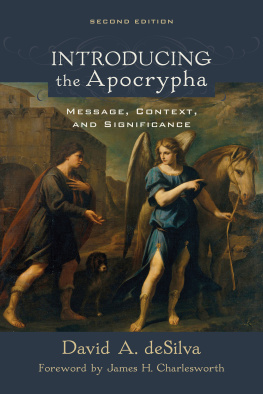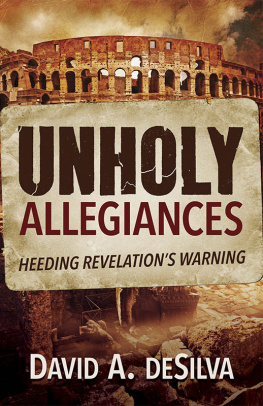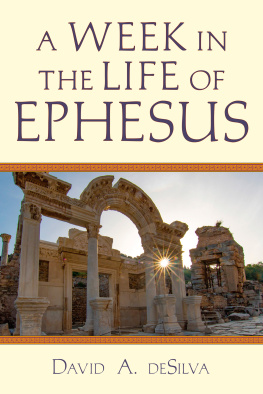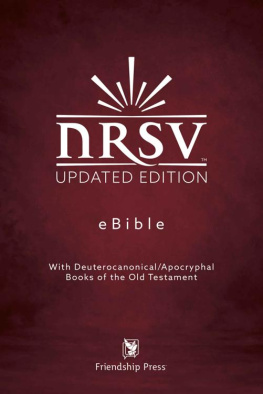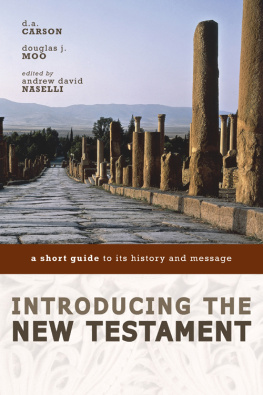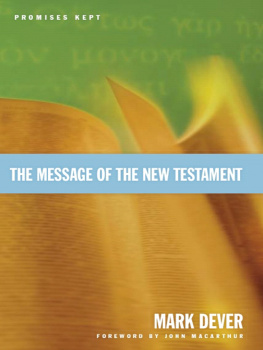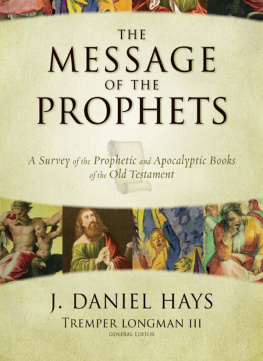David A. deSilva - Introducing the Apocrypha: Message, Context, and Significance
Here you can read online David A. deSilva - Introducing the Apocrypha: Message, Context, and Significance full text of the book (entire story) in english for free. Download pdf and epub, get meaning, cover and reviews about this ebook. year: 2018, publisher: Baker Publishing Group, genre: Religion. Description of the work, (preface) as well as reviews are available. Best literature library LitArk.com created for fans of good reading and offers a wide selection of genres:
Romance novel
Science fiction
Adventure
Detective
Science
History
Home and family
Prose
Art
Politics
Computer
Non-fiction
Religion
Business
Children
Humor
Choose a favorite category and find really read worthwhile books. Enjoy immersion in the world of imagination, feel the emotions of the characters or learn something new for yourself, make an fascinating discovery.
- Book:Introducing the Apocrypha: Message, Context, and Significance
- Author:
- Publisher:Baker Publishing Group
- Genre:
- Year:2018
- Rating:4 / 5
- Favourites:Add to favourites
- Your mark:
- 80
- 1
- 2
- 3
- 4
- 5
Introducing the Apocrypha: Message, Context, and Significance: summary, description and annotation
We offer to read an annotation, description, summary or preface (depends on what the author of the book "Introducing the Apocrypha: Message, Context, and Significance" wrote himself). If you haven't found the necessary information about the book — write in the comments, we will try to find it.
Introducing the Apocrypha: Message, Context, and Significance — read online for free the complete book (whole text) full work
Below is the text of the book, divided by pages. System saving the place of the last page read, allows you to conveniently read the book "Introducing the Apocrypha: Message, Context, and Significance" online for free, without having to search again every time where you left off. Put a bookmark, and you can go to the page where you finished reading at any time.
Font size:
Interval:
Bookmark:
2002, 2018 by David A. deSilva
Published by Baker Academic
a division of Baker Publishing Group
P.O. Box 6287, Grand Rapids, MI 49516-6287
www.bakeracademic.com
Ebook edition created 2018
All rights reserved. No part of this publication may be reproduced, stored in a retrieval system, or transmitted in any form or by any meansfor example, electronic, photocopy, recordingwithout the prior written permission of the publisher. The only exception is brief quotations in printed reviews.
Library of Congress Cataloging-in-Publication Data is on file at the Library of Congress, Washington, DC.
ISBN 978-1-4934-1307-2
Unless otherwise indicated, Scripture quotations are from the New Revised Standard Version of the Bible, copyright 1989, by the Division of Christian Education of the National Council of the Churches of Christ in the United States of America. Used by permission. All rights reserved.
Scripture quotations labeled RSV are from the Revised Standard Version of the Bible, copyright 1952 [2nd edition, 1971] by the Division of Christian Education of the National Council of the Churches of Christ in the United States of America. Used by permission. All rights reserved.
In honor of the God
who was never without a witness in the world
Cover
Title Page
Copyright Page
Dedication
Foreword by James H. Charlesworth
Preface to the Second Edition
Preface to the First Edition
Abbreviations
1. Introduction: The Value of the Apocrypha
2. Historical Context: The Yoke of the Gentiles
3. Tobit: Better Is Almsgiving with Justice
4. Judith: Hear Me Also, a Widow
5. Greek Esther: The Aid of the All-Seeing God and Savior
6. Wisdom of Solomon: The Righteous Live Forever
7. Wisdom of Ben Sira: In All Wisdom There Is the Doing of Torah
8. Baruch: Return with Tenfold Zeal to Seek God
9. Letter of Jeremiah: They Are Not Gods, So Do Not Fear Them
10. Additions to Daniel: Let Them Know That You Alone Are God
11. 1 Maccabees: The Family through Which Deliverance Was Given
12. 2 Maccabees: There Is Some Power of God about the Place
13. 1 Esdras: Leave to Us a Root and a Name
14. Prayer of Manasseh: The God of Those Who Repent
16. 3 Maccabees: Blessed Be the Deliverer of Israel!
17. 2 Esdras: The Mighty One Has Not Forgotten
18. 4 Maccabees: Noble Is the Contest
Bibliographies
Works Cited
Scripture Index
Ancient Writings Index
Author Index
Subject Index
Back Cover
Bending the Knee of the Heart in an Apocryphon: A High-Water Mark in Jewish Theology
J A M E S H. C H A R L E S W O R T H
One of my close colleagues at Duke University for over twenty years was the dean of the chapel, Dr. James Cleland. Pondering whether he was a Christian Jew or a Jewish Christian, Dr. Cleland liked to refer to the Prayer of Manasseh. He would frequently tell the story of a Southern Baptist minister who opened the pulpit Bible and read from this early Jewish prayer. The members of the congregation were amazed at the Christian character of the prayer and told him that it was one of the most insightful and meaningful prayers they had ever heard. They confessed, however, that they could not find the text in their Bibles. He told them it was in their pulpit Bible.
The Prayer of Manasseh is indeed one of the greatest penitential prayers ever composed. Samuel Sandmel once told me that it should have been canonized within the liturgy of the Day of Atonement (Yom Kippur). We do not have the fluid liturgy of Yom Kippur that was directed by the high priest and the Levites in the Jerusalem temple before 70 CE, yet I can imagine the Prayer of Manasseh being read at that time of yearnot only privately but also publicly in synagogues, both in the land and in the Diaspora. Perhaps some in the temple read it, calling on God as they confessed their sins and asked forgiveness.
Those who have focused their lives on the study of prayers frequently tell me that the most deeply spiritual prayers are those composed by early Jews. Subsequently, I often hear the Prayer of Manasseh cited. Once, when I thought my interlocutor was only superficially informed about early Jewish prayers, I was startled to hear the following answer: Well, I do not memorize the titles of prayers you scholars give them. My interest is in the spirituality in a prayer. The individual then quoted the Prayer of Manasseh from memory:
And now behold I am bending the knees of my heart before you;
and I am beseeching your kindness.
I have sinned, O Lord, I have sinned;
and I certainly know my sins.
I beseech you:
forgive me, O Lord, forgive me! (Pr. Man. 1113)
Despite what may be heard in sermons and published in books, Jews during the time of Jesus did acknowledge their sinfulness and confess their sins. In fact, in the temple they established a yearly liturgy and ritual for confessing sins and seeking Gods forgiveness. During this ritual, Yom Kippur, even the high priest, having immersed himself in purifying waters and put on elegant and expensive garments, openly confessed his sins. Centuries later Jews remembered his words:
O Lord, I have committed iniquity, transgressed, and sinned before you, I and my house.
O Lord, forgive the iniquities, transgressions, and sins, which I have done by committing iniquity, transgression, and sin before you, I and my house. ( m. Yoma 3:8)
Manasseh was ancient Israels most wicked king. The Prayer of Manasseh assumes that he recognized and acknowledged his sin. Most scholars, however, conclude that a Jew shortly before the time of Jesus composed this prayer and placed it on the lips of Manasseh. The work is thus both apocryphal (not contained in the canon represented by the Hebrew Bible) and pseudepigraphical (attributed to an ancient Israelite or Jew). Hence, the Prayer of Manasseh has been included in collections of the Old Testament Apocrypha and in the larger corpus of early Jewish religious texts called the Old Testament Pseudepigrapha. The Prayer of Manasseh is included in the Greek Orthodox and Slavonic Orthodox Bibles andof coursewidely available to Roman Catholics since it is deuterocanonical. As we ponder the borders of the canon and the texts that contain Gods Word in the words of Scripture, we hear the cry from the heart of the human who prayed the Prayer of Manasseh, someone so distraught and in need of Gods healing forgiveness that he bent the knees of his heart.
Jews and Christians who wish to learn about their ancient roots need to know aboutindeed readthe so-called apocryphal books. All of the Old Testament Apocrypha are now included in the New Revised Standard Version of the Bible. David deSilvas Introducing the Apocrypha is the best introduction to this ancient corpus. He wisely refuses the glib pronouncement of some professors that the Old Testament Apocrypha are the books added in the Septuagint. This claim fails to observe that such a list varies according to the contents of the ancient manuscripts of the Septuagint. DeSilva thus opts for an inclusive definition of the Apocrypha. He helps the interested reader to comprehend the message, context, and significance of these ancient Jewish compositions. With living and captivating prose, and with erudition and insight, he leads the reader into the thoughts of some great Jewish minds that were imbued with revelation from above. As deSilva makes clear, the Apocrypha are not a threat to faith; they are a vital witness to faith, specifically the faith of Jewish people living in the period between the third century BCE and the first century CE.
Font size:
Interval:
Bookmark:
Similar books «Introducing the Apocrypha: Message, Context, and Significance»
Look at similar books to Introducing the Apocrypha: Message, Context, and Significance. We have selected literature similar in name and meaning in the hope of providing readers with more options to find new, interesting, not yet read works.
Discussion, reviews of the book Introducing the Apocrypha: Message, Context, and Significance and just readers' own opinions. Leave your comments, write what you think about the work, its meaning or the main characters. Specify what exactly you liked and what you didn't like, and why you think so.

